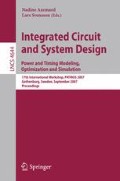Abstract
Within the context of secure applications, side channel attacks are a major threat. The main characteristic of these attacks is that they exploit physical syndromes, such as power consumption rather than Boolean data. Among all the known side channel attacks the differential power analysis appears as one of the most efficient. This attack constitutes the main topic of this paper. More precisely, a design oriented modelling of the syndrome (signature) obtained while performing Differential Power Analysis of Kocher is introduced. As a validation of this model, it is shown how it allows identifying the leaking nets and gates during the logical synthesis step. The technology considered herein is a 130nm process.
Access this chapter
Tax calculation will be finalised at checkout
Purchases are for personal use only
Preview
Unable to display preview. Download preview PDF.
References
Kocher, P., et al.: Differential power analysis. In: Wiener, M.J. (ed.) CRYPTO 1999. LNCS, vol. 1666, pp. 388–397. Springer, Heidelberg (1999)
Daemen, J., Rijmen, V.: Resistance against implementation attacks: a comparative study of the AES proposal. In: Proceedings of the Second Advanced Encryption Standard Candidate Conference (1999)
Goubin, L., Patarin, J.: DES and Differential Power Analysis, the duplication method. In: Koç, Ç.K., Paar, C. (eds.) CHES 1999. LNCS, vol. 1717, pp. 3–15. Springer, Heidelberg (1999)
Messerges, T.S., Dabbish, E.A., Sloan, R.H.: Investigations of power analysis attacks on smartcards. In: USENIX workshop on Smartcard Technology (1999)
Shamir, A.: Protecting Smart Card from passive power analysis with detached power supplies. In: Kaliski Jr., B.S., Koç, Ç.K., Paar, C. (eds.) CHES 2002. LNCS, vol. 2523, pp. 71–77. Springer, Heidelberg (2003)
Tiri, K., verbauwhede, I.: Securing encryption algorithms against DPA at the logic level: next generation smart card technology. In: ESSCIRC 2000 (2000)
Messerges, T.S., et al.: Examining Smart Card Security under the Threat of Power Analysis Attack. IEEE trans. On Computer 51, 541–552 (2002)
Coron, J.S., Kocher, P., Naccache, D.: Statistics and Secret Leakage. In: Bellare, M. (ed.) CRYPTO 2000. LNCS, vol. 1880, pp. 157–173. Springer, Heidelberg (2000)
Mayer-Sommer, R.: Smartly Analysing the Simplicity and the Power of Simple Power Analysis on Smartcards. In: Paar, C., Koç, Ç.K. (eds.) CHES 2000. LNCS, vol. 1965, p. 231. Springer, Heidelberg (2000)
Thomas, D., Moorby, P.: Verilog Hardware description language. Kluwer Academic Publishers, Dordrecht, http://www.whap.com
DES: Data Encryption Standard, FIPS 46-2, www.itl.nist.gov/fipspub/fip46-2.htm
Author information
Authors and Affiliations
Editor information
Rights and permissions
Copyright information
© 2007 Springer-Verlag Berlin Heidelberg
About this paper
Cite this paper
Razafindraibe, A., Maurine, P. (2007). A Model of DPA Syndrome and Its Application to the Identification of Leaking Gates. In: Azémard, N., Svensson, L. (eds) Integrated Circuit and System Design. Power and Timing Modeling, Optimization and Simulation. PATMOS 2007. Lecture Notes in Computer Science, vol 4644. Springer, Berlin, Heidelberg. https://doi.org/10.1007/978-3-540-74442-9_38
Download citation
DOI: https://doi.org/10.1007/978-3-540-74442-9_38
Publisher Name: Springer, Berlin, Heidelberg
Print ISBN: 978-3-540-74441-2
Online ISBN: 978-3-540-74442-9
eBook Packages: Computer ScienceComputer Science (R0)

